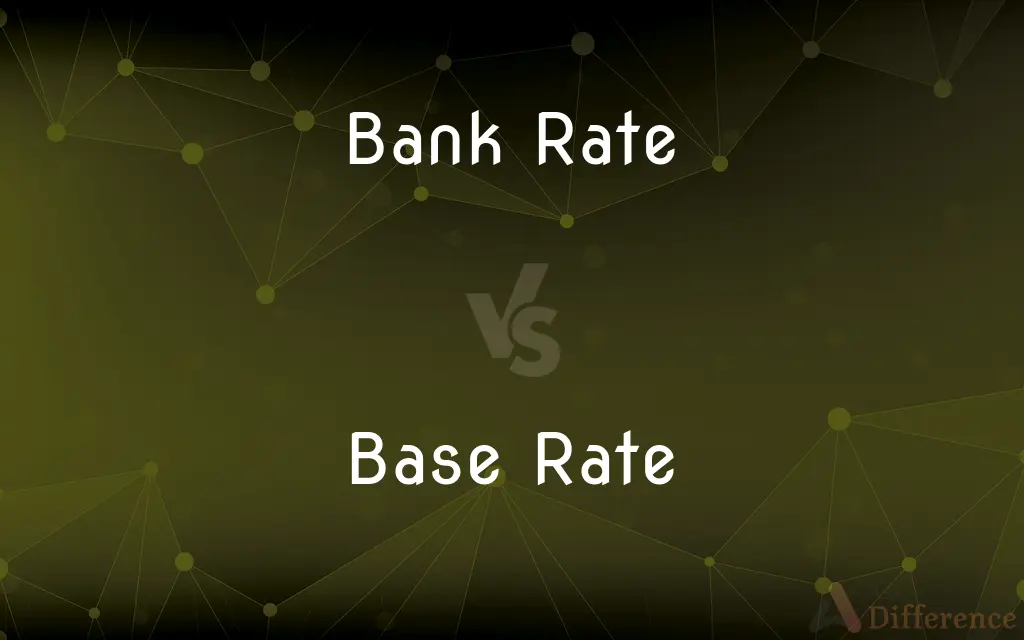Bank Rate vs. Base Rate — What's the Difference?
Edited by Tayyaba Rehman — By Fiza Rafique — Published on October 24, 2023
Bank Rate is the interest rate at which a nation's central bank lends to domestic banks, while Base Rate is the minimum rate set by individual banks below which they cannot lend, except for certain exceptions.

Difference Between Bank Rate and Base Rate
Table of Contents
ADVERTISEMENT
Key Differences
The Bank Rate is a tool used by central banks to control the flow of money in the economy. It signifies the interest rate at which the central bank lends funds to other domestic banks. On the other hand, the Base Rate is determined by individual commercial banks based on their own cost structures and is the lowest rate at which they can lend to customers.
The Bank Rate is a broader monetary policy tool and affects the overall liquidity and money supply in the economy. In contrast, the Base Rate is more specific and directly impacts the lending rates offered to customers by individual banks.
When the central bank adjusts the Bank Rate, it indirectly influences other interest rates in the economy, including the Base Rate of commercial banks. However, each bank's Base Rate can differ from others based on its own costs and profit margins.
In essence, the Bank Rate is a macroeconomic tool, while the Base Rate is more microeconomic, concerning individual banks and their customers.
Comparison Chart
Definition
Interest rate at which the central bank lends to domestic banks.
Minimum rate below which banks cannot typically lend to customers.
ADVERTISEMENT
Determined by
Central bank of a country.
Individual commercial banks.
Purpose
Control money supply and liquidity in the economy.
Ensure that banks cover their costs and maintain profitability.
Effect
Influences overall economic lending rates.
Directly impacts customer loan rates at specific banks.
Scope
Macroeconomic tool.
Microeconomic tool specific to individual banks.
Compare with Definitions
Bank Rate
An indicator of a central bank's stance on monetary policy.
A high Bank Rate usually indicates a restrictive monetary policy.
Base Rate
A reflection of a bank's own cost of funds and operational costs.
The bank revised its Base Rate after assessing its cost structures.
Bank Rate
A monetary policy tool for influencing money supply.
A decrease in the Bank Rate can stimulate economic growth.
Base Rate
The lowest rate at which banks can lend to customers.
The Base Rate of our bank remains unchanged this quarter.
Bank Rate
A determinant of interbank borrowing costs.
Banks might reconsider their borrowing strategies based on the Bank Rate.
Base Rate
A rate set to ensure bank profitability on loans.
The Base Rate ensures that the bank covers its costs while lending.
Bank Rate
The rate at which central banks lend to domestic banks.
The central bank raised the Bank Rate to curb inflation.
Base Rate
An indicator of individual bank's lending strategy.
The bank's competitive Base Rate attracts many borrowers.
Bank Rate
A reflection of the cost of borrowing for banks from the central bank.
An increase in the Bank Rate may lead to higher lending rates for consumers.
Base Rate
A rate below which banks usually don't lend, barring certain exceptions.
Even with a stellar credit score, getting a loan below the Base Rate is challenging.
Common Curiosities
How is the Base Rate defined?
The Base Rate is the minimum rate set by individual banks below which they typically don't lend to customers.
Who determines the Bank Rate?
The nation's central bank determines the Bank Rate.
How do individual banks decide their Base Rate?
Banks determine their Base Rate based on their cost structures and desired profitability margins.
What is the Bank Rate?
The Bank Rate is the interest rate at which a central bank lends to domestic banks.
Does a change in the Bank Rate always affect the Base Rate?
While the Bank Rate can influence the Base Rate, it doesn't guarantee a direct proportional change.
How often can the Base Rate change?
The frequency varies by bank, but changes usually occur in response to varying costs or broader economic conditions.
How does the Base Rate affect a bank's competitiveness?
A competitive Base Rate can attract borrowers, but it's balanced against the bank's need to cover costs and remain profitable.
Why is the Base Rate important for borrowers?
The Base Rate determines the lowest interest rate at which a bank will lend, affecting loan costs for borrowers.
Can banks lend below the Base Rate?
Typically, banks don't lend below the Base Rate, but there might be exceptions based on specific loan categories or customer relationships.
Is the Base Rate the only determinant of a customer's loan rate?
No, while the Base Rate is a significant factor, individual creditworthiness, loan type, and tenure also influence loan rates.
How does a high Bank Rate impact the economy?
A high Bank Rate can lead to higher borrowing costs, potentially slowing down economic growth.
Can the Bank Rate and Base Rate be the same?
Not usually, as the Bank Rate is a central banking tool, while the Base Rate is set by individual commercial banks.
Why might a central bank increase the Bank Rate?
Central banks might raise the Bank Rate to curb inflation, manage money supply, or stabilize the currency.
What's the relationship between the Bank Rate and market liquidity?
A lower Bank Rate can increase market liquidity by making borrowing cheaper for banks, potentially leading to increased lending.
Is the Base Rate applicable globally?
While the concept is global, the actual rate and its implications vary by country, banking regulations, and economic conditions.
Share Your Discovery

Previous Comparison
Cooking Oil vs. Frying Oil
Next Comparison
Aversion vs. DislikeAuthor Spotlight
Written by
Fiza RafiqueFiza Rafique is a skilled content writer at AskDifference.com, where she meticulously refines and enhances written pieces. Drawing from her vast editorial expertise, Fiza ensures clarity, accuracy, and precision in every article. Passionate about language, she continually seeks to elevate the quality of content for readers worldwide.
Edited by
Tayyaba RehmanTayyaba Rehman is a distinguished writer, currently serving as a primary contributor to askdifference.com. As a researcher in semantics and etymology, Tayyaba's passion for the complexity of languages and their distinctions has found a perfect home on the platform. Tayyaba delves into the intricacies of language, distinguishing between commonly confused words and phrases, thereby providing clarity for readers worldwide.












































